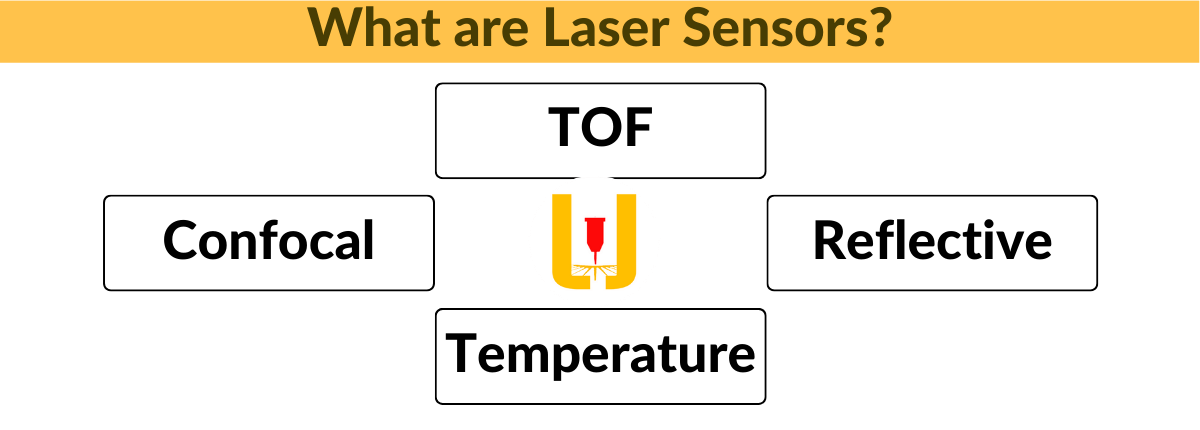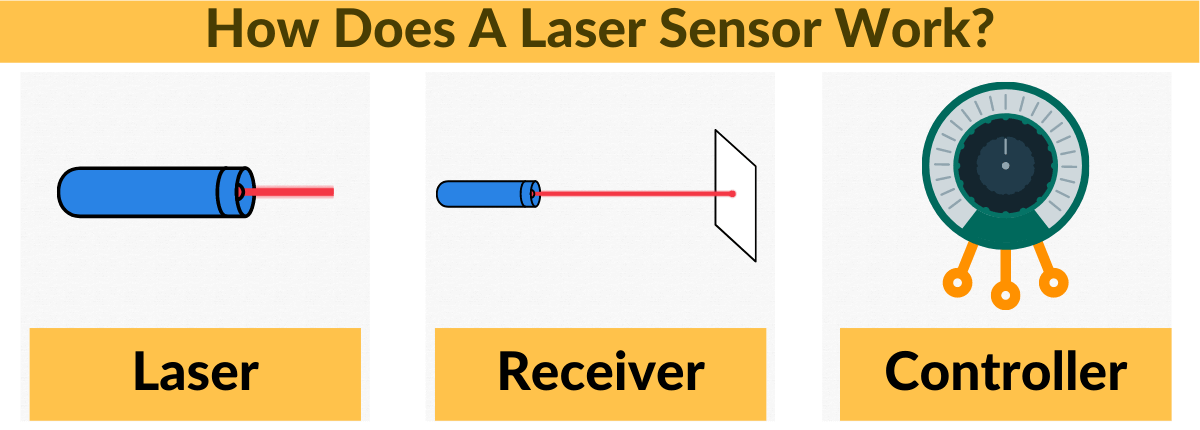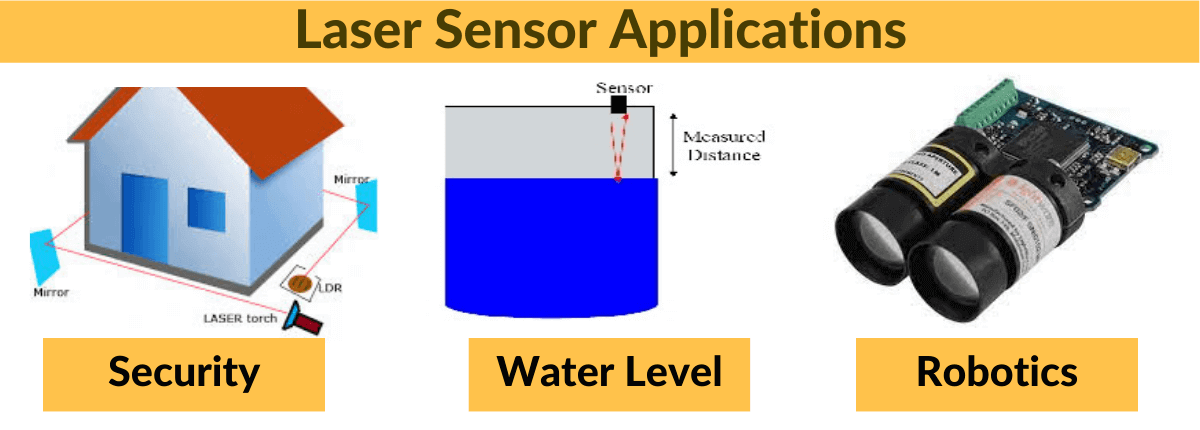We use many sensors in our daily life to enhance our work efficiency. Lasers are one type of these sensors. We can use it for industrial automation, robotics, security, and distance measuring. So, we should know: How does a laser sensor work?
These sensors consist of a transmitter and a receiver.
In this article, I will try my best to answer all related questions about it, that How does a laser sensor work? What are its applications? and How new emerging technologies enhance its working?” To explore this informative talk in detail, let’s proceed.
What are Laser Sensors?
A laser detector is an optical device that uses laser technology to measure distances, detect motion, and analyze surfaces. It emits a laser beam and sends it to a receiver or reflector. After detection, the device generates an electrical signal. It is possible to use these signals for a variety of purposes.
Laser Sensor Types

There are several lazer sensors, each with a unique working mechanism.
Time-of-Flight (ToF) Sensors
Sensors with time-of-flight pulses emit lazer pulses that reflect light from objects when they hit them. The lazer pulse travels from the detector to the measuring object and back. We use the time taken to calculate the distance to the measuring object.
Reflective Sensors
Reflective detectors detect objects by shining a laser-beam on the surface. If an entity is present, it reflects the laser-beam to the sensor receiver. The detector detects the reflection and sends a signal to indicate its presence.
Confocal Sensors
Confocal detector use lazer technology to create a three-dimensional image of an object by focusing the laser-beam on a single point and collecting the reflection with the detector. The sensor moves the laser-beam to different points on the working object to create a 3D image of the surface.
Temperature Sensor
Laser temperature detector are non-contact temperature measurement devices. These sensors use lasers technologies to determine the temperature of an object.
How Does a Laser Sensor Work?

These detectors work in three stages: transmitting the beam, receiving, and controlling the process.
Beam Transmitter
These sensors emit laser-beams directed toward the object being measured or analyzed.
Beam Receiver
The laser-beam reflected the receiver after hitting the object. The reflectivity of an object’s surface affects the amount of lazer energy that reaches the detector.
Controller
The controller detects the reflected laser-beam and converts the reflected energy into an electrical signal. Using this electrical signal, the controller acts according to instructions.
Advantages of Laser Sensors
lazer detector have several advantages over other types of detectors, including:
High Precision
Due to their high precision and accuracy, these detectors are ideal for applications requiring precise results.
High Speed
These detectors can work very quickly, making them suitable for high-speed applications.
High Reliability
These detectors are highly reliable and robust, making them suitable for operation in harsh environments.
Small Size
These detectors are small in size. In compact designs, these sensors are the best option to install instead of other detector types.
Non-contact
Laser detectors can take measurements without making physical contact with the object, making them ideal for applications where physical contact is not possible or desirable.
Applications of Laser Sensor

The use of these detectors are widespread in several industries, including:
Industrial Automation
Laser sensors play a crucial role in industrial automation by providing precise and non-contact measurements for various applications, such as material handling, process control, and quality control.
They can measure distances, detect motion, and analyze surfaces to provide real-time feedback for automated systems. In addition, these detectors can also monitor and control the temperature, flow, and pressure of industrial processes, ensuring their efficiency and accuracy.
The use of these sensors in industrial automation increases productivity and safety.
Robotics
These sensors are widely used in robotics to provide precise and non-contact measurements for various applications, such as navigation, localization, mapping, and object recognition.
They can measure distances, detect motion, and analyze surfaces to help robots perform tasks in real-time.
Providing real-time feedback by these sensors enables robots to make better decisions, perform tasks more accurately, and operate safely.
Distance Measurement
Laser sensors use in applications such as construction, surveying, industrial automation, and robotics to accurately measure distances and position objects. They are also used in safety and security systems, such as park assist and adaptive cruise control, to detect the distance between vehicles and obstacles.
The use of these detectors in distance measurement helps to improve efficiency, accuracy, and safety in various industries and applications.
3D Scanning and Printing
The use of these detector in 3D scanning and printing allows accurate and precise data collection and representation of objects.
It is essential for the development of advanced manufacturing and digital fabrication technologies.
Water Level Measurement
Lazar detectors play a crucial role in water level measurement to determine the height of the water surface. They work by emitting a lazer beam, which is reflected by the water surface and detected by the detector. By this detection, we measure the level of water in the tank.
Future of Laser Sensors
The future of laser detector looks bright, with many advancements and innovations expected in the coming years. Some key trends and areas of focus in the development of laser detectors include:
- Increased Accuracy
- Miniaturization/Portability
- AI/IoT Integration
- Extreme Environments
- New Technologies (Quantum Lasers and Terahertz Lasers)
These sensors will be integrated with artificial intelligence (AI) and the Internet of Things (IoT) to create more intelligent, more connected systems that can process and analyze data in real-time tasks.
Conclusion
I hope you get the answer to “ how does a laser sensor work” and all its related questions. In conclusion, Laser sensors are precise, fast, and non-contact. They are ideal for industrial, scientific, security, and medical applications.
Types of these sensors include Time-of-Flight (ToF), reflective, and confocal detectors. The versatility of these detectors has made them valuable tools in many industries, with continued advancements in technology leading to further growth.
The future of these sensors looks bright with continued advancements in technology. Across industries, from robotics to 3D printing, these detectors remain a crucial tool for precise and fast measurements.
FAQs ( How Does a Laser Sensor Work? )
1. What are the Sensors?
Devices detect changes in physical conditions such as temperature, light, sound, pressure, motion, etc., and convert these changes into electrical signals that a computer or other device can process. These devices are called sensors.
2. How Does a Laser Sensor Work as a Range Finder?
Laser range finders measure distance by emitting a lazar beam and measuring the time for reflection to return.
3. How Does a Laser Sensor Work to Measure Temperature?
Laser temperature detector emit a lazar beam toward an object. They measure the change in wavelength of the reflected light, which is proportional to the temperature of the measuring object.
4. What type of laser sensor do we use for water level measurement projects?
Time-of-Flight lazer Sensor (ToF)
5. How Do Laser Sensors Enhance Security in High-Risk Environments?
lazer detectors enhance security in high-risk environments by providing non-contact, precise measurement of physical parameters such as motion, distance, and presence, reducing the risk of human error and tampering.

